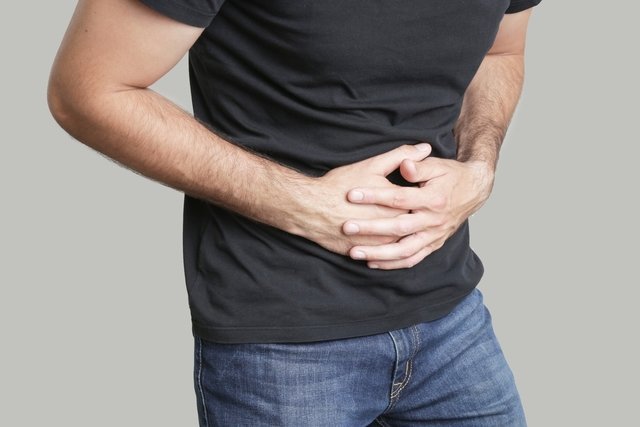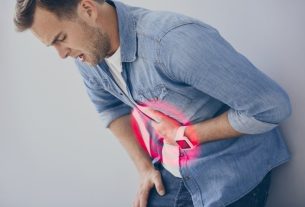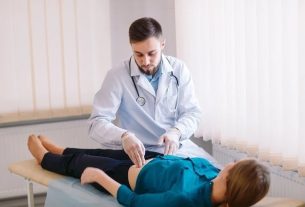Pain on the right side of the belly is often caused by excess gas, but it can also indicate appendicitis, gallstones, kidney infection or pancreatitis, for example.
In addition to pain, it is important to be aware of other symptoms that may appear, such as abdominal distension, fever, vomiting, diarrhea or loss of appetite, for example, which can help the doctor reach a diagnosis.
Whenever the pain is very intense, lasts for more than 3 days or is accompanied by other symptoms, it is important to consult a general practitioner or gastroenterologist to identify the correct cause and begin the most appropriate treatment.
What could be your stomach pain?
To find out the possible cause of your stomach pain, please answer the following questions:
It is important to remember that this tool only serves as a guideline to try to identify the possible cause of belly pain. Therefore, it should not replace a consultation with a doctor, who is the professional responsible for confirming the diagnosis and recommending the most appropriate treatment.
8 causes of pain on the right side of the belly
The most common causes of pain on the right side of the belly are:
1. Excess gas
Abdominal pain on the right side may simply be intestinal distension due to gas, a common situation that can affect people of all ages, from babies to the elderly. This pain is usually strong, in the form of stitches and appears after a meal. This symptom is very common during pregnancy, especially at the end of pregnancy, and also in people with constipation or other changes in the intestinal rhythm. It usually improves with evacuation or elimination of gases.
Other symptoms: Severe stabbing pain, feeling of a swollen belly, loss of appetite, feeling of heaviness in the stomach, as well as increased production of belching or gas, abdominal swelling and a feeling of satiety. The pain can be persistent, it can get worse at times, but it never disappears completely.
What to do: It is recommended to regularize intestinal functioning and facilitate digestion by consuming foods rich in fiber and drinking plenty of water, however, in some cases, it may be necessary to consume laxative medications, such as lactulone, magnesium hydroxide, or bisacodyl, for example. , recommended by the doctor. See more ways to eliminate intestinal gas.
2. Irritable bowel syndrome
People with irritable bowel syndrome experience abdominal pain associated with diarrhea, constipation, or alternating diarrhea and constipation.
Other symptoms: In addition to abdominal pain, diarrhea or constipation, abdominal bloating, gas, nausea and tiredness may be present. The exact cause of this disease is not known, which is more common in people with anxiety, depression or psychological disorders.
What to do: You should go to the doctor to investigate what is causing the pain, excluding other causes, and start treatment. The doctor may ask for more details about how the pain manifests itself, its intensity and what the stool is like. In addition to the use of remedies such as hyoscine, otilonium bromide and pinaverium bromide to combat colic. Diet adjustments are recommended, such as eating in small quantities, slowly and avoiding foods such as beans, cabbage and foods rich in fermentable carbohydrates. Find out more about the treatment of this syndrome.
3. Gallstones
Pain on the right side of the belly could also be a gallstone, which usually manifests as cramping that is generally located on the direct, upper side of the abdomen or in the stomach region, lasting minutes to hours. It can often radiate to the left side or back, or manifest itself only as discomfort or poor digestion.
Other symptoms: In certain cases, gallstones can also cause loss of appetite, nausea and vomiting. When stones cause inflammation of the gallbladder, there may be fever, chills and yellowing of the skin and eyes.
What to do: After the gallstone is confirmed through ultrasound, it is generally recommended to remove the gallbladder through laparoscopy surgery. In patients at high surgical risk, surgery should be avoided and clinical treatment with analgesics and, in some cases, antibiotics, for example, should be used. See how the surgery is performed and what the recovery is like.
4. Appendicitis
Appendicitis causes pain on the right side of the abdomen that begins with a mild cramping sensation around the navel or stomach area. After approximately 6 hours, the inflammation worsens and the pain becomes stronger and more evident in the lower region, close to the groin.
Other symptoms: There is also loss of appetite, nausea, vomiting, the intestine may be very loose or stuck, fever, hypersensitivity in the lower right part of the abdomen and abdominal rigidity.
What to do: If you suspect it, you should go to the emergency room because most of the time it is necessary to have surgery to remove the appendix. Find out everything about appendicitis surgery.
5. Acute Hepatitis
Abdominal pain on the right side of the body, in the upper part of the abdomen, can be one of the symptoms of hepatitis. This disease is an inflammation of the liver that has several causes, from viral and bacterial infections, alcoholism, medication use, autoimmunity or degenerative diseases.
Other symptoms: Nausea, vomiting, loss of appetite, headache, dark urine, yellowish skin and eyes or pale stools may also be present.
What to do: You need to drink plenty of water and avoid foods that are difficult to digest. Some medications may be recommended by your doctor, especially to reduce symptoms of pain and nausea. See the main causes and how to treat hepatitis.
6. Pancreatitis
In pancreatitis, abdominal pain is usually located in the upper part of the abdomen and radiates to the back. It may appear shortly after consuming alcoholic beverages or a meal.
Other symptoms: In addition, there may be nausea, vomiting, fever, low blood pressure, a palpable mass in the painful area, yellowish skin,
What to do: In case of suspicion, you should go to the emergency room for tests such as an ultrasound or tomography. Treatment may include taking painkillers and antibiotics. In rare cases, surgery is the best option. Find out all the details about pancreatitis treatment.
7. Pain during ovulation
Some women experience pain on the ovulating side of the ovary, also known as mid-cycle pain. The pain is not very strong, but it can be present during the days of ovulation, and it is easy to notice why one month it is on the right side of the body, and the next month it is on the opposite side.
This pain is considered normal and although it can be very intense, it is not a cause for concern.
Other symptoms: The main symptom is abdominal pain on one side of the body in the form of a stitch, stitch, cramp or colic, around 14 days before menstruation, in a 28-day cycle.
What to do: As ovulation pain only lasts 1 day, simply take an analgesic or anti-inflammatory, such as paracetamol or naproxen, to relieve this discomfort. If you have any doubts, you can talk to your gynecologist to confirm this hypothesis. Find out everything about ovulation pain.
Furthermore, it is possible to resort to non-pharmacological options, such as applying heat to the region, such as a compress, for example.
8. Renal colic
The presence of kidney or bladder stones can obstruct the flow of urine, which can cause moderate to severe pain, generally on the affected side and which can radiate to the back or genitals.
The pain can start suddenly and is more common in people between 30 and 60 years of age, with the same frequency in men and women.
Other symptoms: Some symptoms that may accompany pain are nausea, vomiting, chills, pain when urinating, bleeding in the urine and, in case of infection, fever.
What to do: In addition to going to the emergency room for clinical evaluations and examinations to be carried out, the doctor may recommend medications such as anti-inflammatories, analgesics and antispasmodics to alleviate symptoms. Find out what to do to relieve renal colic.
When to go to the hospital
Warning signs that indicate the need to go to the hospital are:
- Pain that appears suddenly and is very strong, localized or that gradually gets worse;
- If there is a fever, or difficulty breathing;
- If there is high blood pressure, tachycardia, cold sweat or malaise;
- Vomiting and diarrhea that don’t go away.
In these cases, in addition to evaluating the signs and symptoms, the doctor may also order diagnostic tests, such as ultrasound or computed tomography.

Sign up for our newsletter and stay up to date with exclusive news
that can transform your routine!
Warning: Undefined array key "title" in /home/storelat/public_html/wp-content/plugins/link-whisper-premium/templates/frontend/related-posts.php on line 12
Warning: Undefined array key "title_tag" in /home/storelat/public_html/wp-content/plugins/link-whisper-premium/templates/frontend/related-posts.php on line 13




